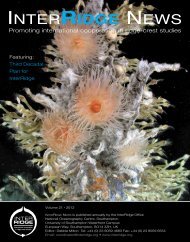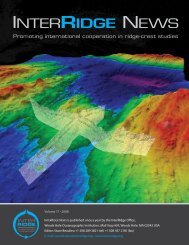T h e h e a lt h o f t h e e a r t h ’ s o c e a n depends upon a well-informed citizenry. Since earlydiscussions of the role of scientists in education reform (AAAS, 1989), the call for scientists to becomeinvolved has grown louder and more urgent; research directorates of funding agencies, such as the USNational Aeronautics and Space Administration (NASA) and National Science Foundation (NSF), nowencourage better integration of science and education (National Science Foundation, 1997). Today’s educationand public outreach (EPO) landscape, which facilitates interaction between scientists and publicaudiences, has become much more complex. <strong>The</strong> complexity is due to several factors, including morethan a decade of legislative and research-based developments in science education, rapidly changing audienceneeds combined with new ways of reaching these audiences, increasing science literacy efforts,collaborations of professionals that have not traditionally worked together (e.g., scientists, learningresearchers, formal and free-choice educators, school districts, industrial partners andothers), and more attention paid to evaluating the effectiveness of outreach programs.In the United States, EPO programs operate against a backdrop of shrinking scienceand education budgets, declining K–12 science test scores (Baker et al., 2005), andlagging competitiveness in science and technology (National Academies, 2006).<strong>The</strong> question today is not whether to do outreach, but rather what are the mosteffective ways to reach out to citizens and help them develop a better understandingof the world we all live in.Increased awareness of the importance of EPO within the scientificcommunity is reflected in the number of EPO-related sessions held atthe American Geophysical Union (AGU) fall meeting. In 1999, AGU firstimplemented 10 education sessions. In 2006, the fall meeting featured36 education sessions, six public-affairs sessions, and six additional sessionsfocused specifically on “Communicating Broadly: Perspectives andTools for Ocean, Earth, and Atmospheric Scientists.” In short, the EPOterrain has become more challenging and more interesting to navigate.<strong>The</strong> good news for scientists is that many more opportunities to do outreachnow exist and more EPO professionals are available to support scientistsin time- and cost-effective ways.<strong>The</strong> goals of this article are threefold: (1) to outline the main challengesinherent in today’s EPO landscape in order to foster a better understandingof effective EPO, (2) to explain the appeal and challenges of the ocean spreadingcenters or mid-ocean ridges as an EPO thematic tool and to present examplesof current outreach efforts, and (3) to provide a list of resources useful for scientistsinterested in extending the value of their research beyond the academic arena.Photos left to right. Visitors to the InterRidge outreach exhibit held at the EuroScience Open Forum (ESOF) in Munich, Germanylast July try their hand at navigating submersibles around vent chimney models. InterRidge Science Writer-at-Sea student BeccaGentry, right, of Columbia University gets survival suit training in Bergen, Norway, along with scientists before embarking on anexpedition in summer 2005 (Principal investigators: Rolf Pedersen and Ingunn Thorseth). Becca Gentry photographs the interestinglandscape surrounding Jan Mayen, the world’s northernmost active volcano, on the first Science Writer-at-Sea expedition.Courtesy of K.M. Kusek, InterRidge<strong>Oceanography</strong> March 2007 143
Challenges and Realitiesof Today’s EPOIn this article we address four topics thathave added depth to the EPO landscapein the United States by creating newchallenges and opportunities. <strong>The</strong>y are:changing audience needs, national scienceeducation standards and ocean literacyefforts, new outreach technologies,and diverse EPO networks. <strong>The</strong> briefdiscussions of each topic below, whilenot exhaustive, will help demystify theway EPO works by shedding light on thechallenges across the EPO landscape.Changing Audience NeedsEPO professionals have learned fromexperience the importance of tailoringinformation to the interests and needs ofthe chosen audience. “One size fits all”does not work. <strong>The</strong> interests and needsof a sixth grader sitting in an earth scienceclass, for example, are very differentfrom those of a 65-year-old visiting anearby science center, and also differentfrom those of a college student readinga magazine or newspaper article.Furthermore, educational standardsdiffer from country to country; customizingthe message to the particularKristen M. Kusek (kristenkusek@aol.com) is Science Writer and Education OutreachCoordinator, InterRidge (branch office),Cambridge, MA, USA. Liz Goehringis Ridge 2000 Education Outreach Coordinator,<strong>The</strong> Pennsylvania State University,Department of Biology, University Park, PA,USA. Véronique Robigou is ResearchScientist and Director of COSEE OceanLearning Communities and REVEL Project,University of Washington, School of <strong>Oceanography</strong>,Seattle, WA, USA.needs of different cultures is challenging,to say the least.Nonetheless, the first question askedupon embarking on an outreach programis similar to what marketingprofessionals ask before starting a newadvertising campaign: who preciselyis the audience? <strong>The</strong> next question is:what kind of outcome is sought? Do wewant the audience to become morewell informed, or to “act” and even“do” something? <strong>The</strong>se basic marketingprinciples are not only relevant inEPO, but underscore the ultimate effectivenessof any well-designed outreachprogram (Sturm, 2006).Today’s EPO efforts can also drawfrom learning-theory research to bettertarget different audience needs. New insightsinto how people, especially today’s“point-and-click” generation, learn—whether tactile, auditory, or hands-on—continually guide the outreach methodsEPO professionals use every day.National Science EducationStandardsBasic science literacy is essential if weexpect people to make informed decisionsabout the environment or sciencefunding. Unfortunately, four out of fiveAmericans do not understand the sciencesection of the New York Times or similarmaterials (Miller, 2004), and one in fiveAmerican adults thinks the sun revolvesaround the earth (reported by Millerin Dean, 2005). <strong>The</strong> need for enhancedscience literacy has been recognized bythe science and education communitiesfor decades. <strong>The</strong> American Associationfor the Advancement of Science (AAAS)initiated a significant effort toward enhancedscience literacy in the UnitedStates with its publication of Science forAll Americans (AAAS, 1989) and its classroomcompanion, Benchmarks for ScienceLiteracy (AAAS, 1993). <strong>The</strong>se werefollowed by National Science EducationStandards from the National ResearchCouncil (1996), which observes thatcontent standards and benchmarks guideeducators toward a science-literate societywhen “…they outline what studentsneed to know, understand, and be able todo to be scientifically literate at differentgrade levels.” Effective science educationprograms today are standards-based, useinquiry approaches, and are rooted inadvanced learning theories (See Meeson,2005/2006, for examples). <strong>The</strong>y alsorequire significant effort to plan, design,and implement.EPO professionals must be well versedin nationally accepted education standards,and keep pace with the ongoingevolution taking place at each grade levelof these standards. Further, each state inthe United States has its own suite of statescience standards, concepts, and “strands”that teachers are required to teach andthat are reflected in state assessment tests.If a topic is not addressed in the standards,it will most likely not be taught inthe classroom. EPO professionals must bemindful of the necessary balance betweencreative innovation and the constraintsof today’s standards and assessmentorientedclassroom.Especially relevant to <strong>Oceanography</strong>magazine and the ridge science communityis the concept of “ocean literacy,” amore specific form of science and earthscience literacy that has now taken rootacross the EPO landscape (see Cava et al.,2005). Ocean-related concepts were notoriginally part of the nationally accepted144<strong>Oceanography</strong> Vol. 20, No. 1
















